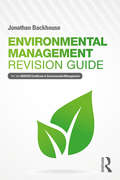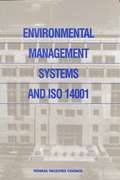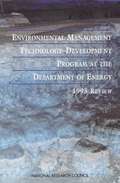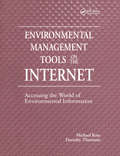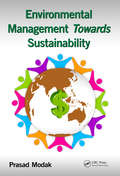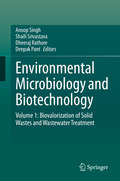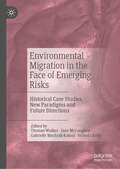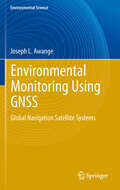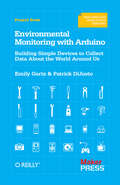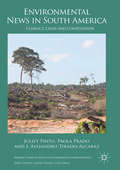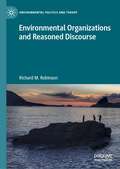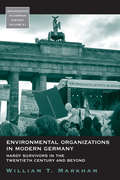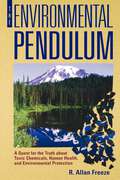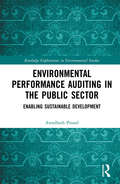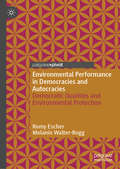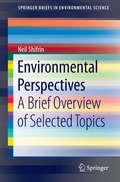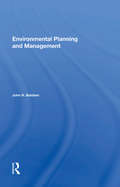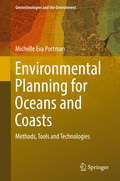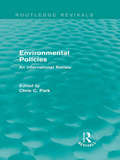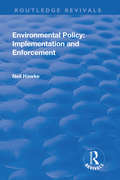- Table View
- List View
Environmental Management Revision Guide: For the NEBOSH Certificate in Environmental Management
by Jonathan BackhouseThe Environmental Management Revision Guide: For the NEBOSH Certificate in Environmental Management is the perfect revision aid for students preparing to take their NEBOSH Certificate in Environmental Management. As well as being a handy companion volume to Brian Waters’ NEBOSH-endorsed textbook Introduction to Environmental Management, it will also serve as a useful aide-memoire for those in environmental management roles. The book aims to: Provide practical revision guidance and strategies for students Highlight the key information for each learning outcome of the current NEBOSH syllabus Give students opportunities to test their knowledge based on NEBOSH style questions and additional exercises Provide details of guidance documents publically available that students will be able to refer to. The revision guide is fully aligned to the current NEBOSH syllabus, providing complete coverage in bite-sized chunks, helping students to learn and memorise the most important topics. Throughout the book, the guide refers back to the Introduction to Environmental Management, helping students to consolidate their learning.
Environmental Management Systems and ISO 14001
by Federal Facilities Council National Research Council Commission On Engineering Technical Systems Division On Engineering Physical SciencesIn 1996, the Federal Facilities Council (FFC), which operates under the aegis of the National Research Council, established a standing committee on Environmental Engineering with the express purpose of providing a forum where federal environmental engineers and program managers could meet on a regular basis to exchange information about facilities-related environmental programs, policies, and issues. The committee members, like environmental program managers in other types of organizations, are increasingly concerned about achieving and demonstrating sound environmental performance by meeting the requirements of environmental regulations and limiting the impacts of their products or services on the environment. To foster communication and address concerns about EMSs, the FFC Standing Committee on Environmental Engineering hosted a one-day workshop on Environmental Management Systems and ISO 14001. The workshop was held April 9, 1998, at the National Academy of Sciences in Washington, D.C.
Environmental Management Technology-Development Program at the Department of Energy 1995 Review
by Committee on Environmental Management TechnologiesThis book provides the National Academy of Sciences' 1995 review of the technology development program for the remediation of the Department of Energy's weapons complex facilities. It makes scientific, technical, and programmatic recommendations to strengthen technology development within DOE and ensure that it meet its goals of cost effectiveness, safety, and decreased risk. The recommendations address DOE's five focus areas: landfill stabilization; contaminant plume containment and remediation; facility transitioning, decommissioning, and final disposition; mixed waste characterization treatment; and high-level waste in tanks. The book also addresses technologies in areas that cross cut the above focus area programs, namely characterization monitoring and sensor technologies, efficient separations and processing, robotics, and waste disposal.
Environmental Management Tools on the Internet: Accessing the World of Environmental Information
by Michael KatzThis book provides general information about what is on the Internet and how to access it. It shows how o get environmental information off of the Internet. The book covers the database services that are available on the Internet that charge fees.
Environmental Management towards Sustainability
by Prasad ModakThis book is about understanding challenges in managing our environment and ensuring sustainability of this planet. It presents the critical state of our resources and threats to resource security due to overconsumption, pollution and poor and uneven governance. Role of key stakeholders such as the Government, Financing Institutions, Business and Communities is important. These stakeholders need to collaborate at multiple levels – viz. Local, Regional, National and Global. Chapters are devoted to describing the role of the above stakeholders with numerous case studies. The book can serve as a textbook to academia, a reference for policy makers and planners and a resource for conducting continuing education programs for the professionals to introduce both the concepts and practice experience on sustainability.
Environmental Markets
by Terry L. Anderson Gary D. LibecapEnvironmental Markets explains the prospects of using markets to improve environmental quality and resource conservation. No other book focuses on a property rights approach using environmental markets to solve environmental problems. This book compares standard approaches to these problems using governmental management, regulation, taxation, and subsidization with a market-based property rights approach. This approach is applied to land, water, wildlife, fisheries, and air and is compared to governmental solutions. The book concludes by discussing tougher environmental problems such as ocean fisheries and the global atmosphere, emphasizing that neither governmental nor market solutions are a panacea.
Environmental Mediation: An International Survey (Routledge Research in International Environmental Law)
by Catherine Choquette Véronique FraserEnvironmental mediation continues to develop and evolve in different jurisdictions across the world in order to prevent potential environmental conflicts or to resolve the conflicts while avoiding the inherent drawbacks of an adjudicated solution. This book takes a comparative approach to explore the legal framework of environmental mediation with a focus on the judicial, administrative and private procedures and the criteria for accrediting mediators in a range of jurisdictions across the world. It also examines practical considerations for environmental mediators while analysing the effectiveness of different mediation processes.
Environmental Microbiology and Biotechnology: Volume 1: Biovalorization of Solid Wastes and Wastewater Treatment
by Anoop Singh Shaili Srivastava Dheeraj Rathore Deepak PantThis book provides up-to-date information on the state of the art in applications of biotechnological and microbiological tools for protecting the environment. Written by leading international experts, it discusses potential applications of biotechnological and microbiological techniques in solid waste management, wastewater treatment, agriculture, energy and environmental health. This first volume of the book “Environmental Microbiology and Biotechnology,” covers three main topics: Solid waste management, Agriculture utilization and Water treatment technology, exploring the latest developments from around the globe regarding applications of biotechnology and microbiology for converting wastes into valuable products and at the same time reducing the environmental pollution resulting from disposal. Wherever possible it also includes real-world examples. Further, it offers advice on which procedures should be followed to achieve satisfactory results, and provides insights that will promote the transition to the sustainable utilization of various waste products.
Environmental Migration in the Face of Emerging Risks: Historical Case Studies, New Paradigms and Future Directions
by Thomas Walker Victoria Kelly Jane McGaughey Gabrielle Machnik-KekesiThis book will provide a space for new and emergent research in environmental migration, particularly in the context of a world beginning to emerge from the grip of a debilitating public health crisis that kept many firmly rooted in place while displacing others internationally. With famines, vast wildfires, droughts, and record heatwaves uprooting human settlements internationally, research on migration in the face of emerging risks is all the more urgent. As Balsari, Dresser, & Leaning point out, “the wall-building, xenophobic, and insular” platforms of some global powers in their immigration and asylum policies, and the ever-increasing stresses placed on the natural world that continue to make sites of human settlement less and less hospitable, make research on this topic both very timely and much needed. This book will include numerous case studies, historical analyses, projections, models, and recommendations for both policy and future research directions. Contributions are drawn from academics and practitioners in this fertile interdisciplinary field of academic inquiry, and each one focuses on the intersection of population and environment studies, history, geography, law, diaspora studies, economics, public health, and sociology.This book is composed of five clear sections. The introductory section includes one chapter that presents an overview of the current landscape, the scope and objectives of the book, as well as its specific approach and the various themes. The concluding section is composed of one chapter that presents a global map of recent innovations drawing together some of the core themes discussed throughout the book. The concluding chapter synthesizes the challenges and opportunities presented, and the possible future directions that researchers, practitioners, and regulators could and should move towards.
Environmental Monitoring using GNSS
by Joseph L. AwangeGlobal Navigation Satellite Systems (GNSS) are revolutionizing the world in a way their original developers never envisaged. From being military "war" tools, GNSS satellites are rapidly becoming "peace" tools that play a potentially critical role in enabling changing environmental phenomenon that do not permit direct measurements to be remotely observed via their all-weather, highly accurate and continuously updatable positional time series. This is evident, for example, in their use in emerging environmental monitoring methods that are considered in this book. These include: GPS-based radio telemetry, which is enhancing ecological and conservation monitoring by more accurately mapping animal movements, their behaviours, and their impact on the environment; GNSS-meteorology, which is contributing to weather and climate change studies; GNSS-remote sensing, which, for example, allows the rapid monitoring of changes in fresh water resources and cryosphere; Geosensor network techniques, which are earning a crucial role in disaster response management; Epidemiology, for improved efficiency in tracking and studying the spread of infectious diseases and climate change effects on vector-borne diseases; and Economics, to provide data for the econometric modelling of casual impact of policies. In Environmental Impact Assessments (EIA), Strategic Environmental Assessments (SEA), and Sustainability Assessments (SA), GNSS, together with other spaced-based remote sensing techniques, are emerging, not only as modern tools that connect the developers to the community, but also provide information that support Multi-Criteria Analysis (MCA) methods, which inform decision making and policy formulations. By bringing the two fields of geodesy (the parent of GNSS technology) and environmental studies (potential users of this technology), this book presents the concepts of GNSS in a simplified way that can, on the one hand, be understood and utilised by environmentalists, while on the other, outlines its potential applications to environmental monitoring and management for those engaged more with its technology, which hopefully will further energise the already innovative research that is being carried out. Lastly, this book is most relevant to all the professionals whose work is related to the environment such as hydrologists, meteorologists, epidemiologists, economist, and engineers, to name just a few.A comprehensive yet candid and compelling presentation of Global Navigation Satellite Systems and its application to environmental monitoring and a host of other socio-economic activities. This is an essential and new ground breaking reading for all professional practitioners and even academics seeking to study and become involved in using Global Navigation Satellite Systems in diverse fields ranging from environmental monitoring to economic activities such as monitoring weather and climate in order to design crop failure insurance. Nathaniel O. Agola, Professor of Business and Financial Economics, Ritsumeikan University, Japan
Environmental Monitoring with Arduino
by Emily Gertz Patrick Di Justo<p>Right now, thousands of people worldwide are tracking environmental conditions with monitoring devices they’ve built themselves. You can do it too! This inspiring guide shows you how to use Arduino to create gadgets for measuring noise, weather, electromagnetic interference (EMI), water purity, and more. You’ll also learn how to collect and share your own data, and you can experiment by creating your own variations of the gadgets covered in the book. If you’re new to DIY electronics, the first chapter offers a primer on electronic circuits and Arduino programming.</p>
The Environmental Movement: Then and Now (America: 50 Years of Change)
by Rebecca StefoffDiscusses the main concerns of the environmental movement in the 1960s, and how those have evolved since; what's changed for the better, what might be worse, and where do we go from here.
Environmental News in South America
by Juliet Pinto Paola Prado J. Alejandro Tirado-AlcarazCombining perspectives from media studies and political ecology, this book analyses socially constructed news regarding three environmental conflicts in South America. In recent decades, South American political administrations have tied national economies to neo-extractive development strategies, creating not only vulnerabilities to global commodity boom and bust pricing cycles, but also to conflict regarding environmental and cultural degradation from extraction activities. Environmental contestations among indigenous peoples, environmental and social NGOs, state actors, and extraction industries receive media attention, but how these disputes are covered has implications for understandings of media performance in democratizing nations. The authors examine three case studies of environmental contestation in a region that is simultaneously vulnerable to the effects of climate change, and yet has become once again dependent on commodity exportation to industrializing and industrialized nations for economic benefit and social development strategies.
Environmental Organizations and Reasoned Discourse (Environmental Politics and Theory)
by Richard M. RobinsonThis book explores the meaning and role of “fair and reasoned discourse” in the context of our institutions for environmental decision processes. The book reviews the roles of our “environmental advocacy organizations”—such as The Sierra Club, The Audubon Society, the Environmental Defense Fund—in providing and ensuring that our discourse and decisions are fair and reasoned according to the criteria of being (i) inclusive of input from all affected, (ii) informed of relevant scientific and socio-economic information, (iii) uncorrupted by direct conflicts of interest, and (iv) logical according robust review by uncorrupted judges. These organizations are described and examined as expressions of “collective imperfect duty,” i.e. the coordinated duties with environmental direction. The current state of our discourse is examined in light of this fairness criteria, particularly in consideration of the cross-border problems that threaten tragedies of the global commons.
Environmental Organizations In Modern Germany: Hardy Survivors in the Twentieth Century and Beyond (Monographs in German History #21)
by William T. MarkhamGerman environmental organizations have doggedly pursued environmental protection through difficult times: hyperinflation and war, National Socialist rule, postwar devastation, state socialism in the GDR, and confrontation with the authorities during the 1970s and 1980s. The author recounts the fascinating and sometimes dramatic story of these organizations from their origins at the end of the nineteenth century to the present, not only describing how they reacted to powerful social movements, including the homeland protection and socialist movements in the early years of the twentieth century, the Nazi movement, and the anti-nuclear and new social movements of the 1970s and 1980s, but also examining strategies for survival in periods like the current one, when environmental concerns are not at the top of the national agenda. Previous analyses of environmental organizations have almost invariably viewed them as parts of larger social structures, that is, as components of social movements, as interest groups within a political system, or as contributors to civil society. This book, by contrast, starts from the premise that through the use of theories developed specifically to analyze the behavior of organizations and NGOs we can gain additional insight into why environmental organizations behave as they do.
The Environmental Pendulum: A Quest for the Truth about Toxic Chemicals, Human Health, and Environmental Protection
by R. Allan FreezeThe pendulum of environmental policy swings from one extreme to the other, depending on which camp is in power and who has the ear of the media. Underkill is followed by overkill. Concern breeds action; disillusion breeds reaction. The Environmental Pendulum provides a thoughtful and evenhanded assessment of this conflict. Tens of thousands of sites across the country are contaminated with toxic chemicals. Environmentalists warn us that this legacy of carelessness is seriously affecting both human health and the ecological balance of nature. They point out that even improved industrial practices will not eliminate future chemical releases to the environment. Their demand for regulatory control has received wide public support and led to the passage of the Superfund legislation in 1980. Now, after twenty years, the value of the Superfund program is being challenged by corporate America, which argues that excessive cleanup costs have the potential to bankrupt the nation. R. Allan Freeze outlines the difficulties associated with the management of hazardous waste and offers a balanced account of the controversy over the role of environmental contamination in human health. Freeze clarifies what matters and what doesn't with respect to chemical contaminants in the environment, arguing that environmental policies should be based on an accurate appraisal of the risks associated with these toxins. He concludes the book with a brilliant summation of the good news and the bad news of environmental pollution, describing what can and can't be done to bring the situation under control.
Environmental Performance Auditing in the Public Sector: Enabling Sustainable Development (Routledge Explorations in Environmental Studies)
by Awadhesh PrasadEnvironment and sustainable development challenges are a matter of global concern. Trillions of dollars of mostly public money are invested every year in domestic and international policies and programs to address these challenges. The effectiveness of these policies and programs is critical to environmental sustainability. Performance audits that examine the effectiveness of governmental policies and programs heavily influence their implementation. Despite this, performance auditing in the environment field has received very little academic attention. This book takes a closer look at performance auditing of public sector environmental policies and programs. It examines trends in global environmental performance auditing; and how it is currently practiced drawing on a global survey and case studies from Canada, India and Australia. In doing so, it identifies issues and challenges faced by Supreme Audit Institutions in undertaking these performance audits. This book will be of interest to students, scholars and practitioners of sustainable development, environmental auditing and public sector auditing as well as to donor organisations engaged in these areas.
Environmental Performance in Democracies and Autocracies: Democratic Qualities and Environmental Protection
by Romy Escher Melanie Walter-RoggThere are considerable differences in environmental performance and outcomes across both democracies and autocracies, but there is little understanding of how levels of democracy and autocracy influence environmental performance. This book examines whether analysing the effects of individual democratic features separately can contribute to a better understanding of cross-national variance in environmental performance. The authors show that levels of social equality in particular, as well as the strength of local and regional democracy, contribute significantly to explaining cross-national variation in environmental performance. On the other hand, a high level of political corruption affects a country’s ability to adopt and implement environmental policies effectively. In exploring the inter-relationship between democratic qualities, political corruption, and environmental performance, this book presents policymakers and political theorists with a clear picture of which aspects of democratic societies are most conducive to producing a better environment.
Environmental Personhood: New Trajectories in Law (New Trajectories in Law)
by Francine RochfordThis book examines the increasingly widespread movement to recognise the environment as a legal person. Several countries have now recognized that nature, or parts of nature, have juristic personhood. In this book, the concept of legal personhood and its incidents are interrogated with a view to determining whether this is, or could be, a positive contribution to modern environmental problems. Surveying historical and current positions on the juristic concept of legal personhood, the book engages recent legislation and case law, in order to consider the attempt in several countries to vest personhood in rivers, river basins and ecosystems. Comparing approaches in a range of countries – including New Zealand, India, Ecuador, the United States and Australia, it addresses the methods employed, the purported aims, the mechanisms for enforcement, and the entrenchment of legal protections. Throughout, the book elicits the difficult relationship between an historically anthropocentric idea of personhood and its extension beyond the human; concluding that the attribution of personhood to the environment is an important, but limited, contribution to environmental sustainability. Accessibly written, this book will appeal to scholars, students and others with interests in environmental law, environmental science and public policy, and ecology more generally.
Environmental Perspectives
by Neil ShifrinThis short, readable book is intended as a big-picture introduction/overview for environmental students and lay-people involved with environmental issues. Every freshman in college intending to study environmental science should read it. It begins with a historical perspective on waste and environmental control. Basic instruction on some important fundamentals faced by environmental professionals every day, such as sampling, analysis, data visualization, risk assessment and forensic chemistry are provided in the following chapter. Important regulatory fundamentals, such as the National Contingency Plan, which is the U. S. regulatory framework for addressing hazardous waste is also defined. The book concludes with pertinent and provocative considerations on the future of environmental management, such as alternative approaches (technical impracticability), the "not-in-my-backyard syndrome," and the safety of chemicals in consumer products. The book contains many useful facts about waste production rates, energy use and recycling rates--all referenced to allow substantiation and provide a springboard for further research.
Environmental Philosophy: From Animal Rights to Radical Ecology
by Michael E. Zimmerman J. Baird Callicott John Clark Irene J. Klaver Karen J. WarrenEdited by leading experts in contemporary environmental philosophy, this anthology features the best available selections that cover the full range of positions within this rapidly developing field. Divided into four sections that delve into the vast issues of contemporary Eco-philosophy, the Fourth Edition now includes a section on Continental Environmental Philosophy that explores current topics such as the social construction of nature, and eco-phenomenology. Each section is introduced and edited by a leading philosopher in the field. For professionals with a career within the environmental field including law, politics, conservation, geography, and biology.
Environmental Planning And Management
by John H BaldwinA comprehensive overview and discussion of all major aspects of environmental planning and management, Professor Baldwin's textbook highlights the causes and interrelationships of environmental problems, emphasizing the important economic and ecological functions of the land as the stage for all human activities and the "source" and "sink" for all
Environmental Planning for Oceans and Coasts
by Michelle Eva PortmanThis book informsenvironmental planning professionals, students and those interested in oceansand coasts from an environmental perspective about what is needed for planningand management of these unique environments. It is comprised of twelve chaptersorganized in three parts. Part I highlights the basics tenets of environmentalplanning for oceans and coasts including important concepts from the generalfield of planning and coastal and ocean management (e. g. , hydrography, oceanspolicy and law, geomorphology). Environmental problems inherent within oceansand coasts (such as sea level rise, marine pollution, overdevelopment, etc. )are also addressed, especially those at the land-sea interface. Part II coversthose methodological approaches regularly used by planners working to improveenvironmental quality and conditions of oceans and coasts among them: integrated planning andmanagement, ecosystem services, pollution prevention, and marine spatialplanning. Part III focuses specifically on state-of-the-art tools andtechnologies employed by planners for marine and coastal protection. Theseinclude systematic conservation planning for protected areas, decision supporttools, coastal adaptation techniques and various types of communication, includingvisualization, narration and tools for stakeholder participation. The finalchapter in the book reviews the most important concepts covered throughout bookand emphasizes the important role that environmental planners have to play inthe protection and well-being of oceans and coasts. Michael K. Orbach, of the Nicholas School of the Environment at Duke University, pennedthe book's foreword.
Environmental Policies: An International Review (Routledge Revivals)
by Chris C. ParkThe importance of the effective management of the natural environment has become vital over the past few decades. In different countries, varying policies are implemented by governments to manage the environment, both to foster growth and reduce pollution and destruction. Employing a broad country-based approach, this edited collection, first published in 1986, surveys the growth, nature and effectiveness of the environmental management policies implemented by governments around the world. The overarching argument is that a coherent international approach is needed to deal with the problems surrounding environmental sustainability. This title will be of great value to students of the natural environment, sustainability and resource management.
Environmental Policy: Implementation and Enforcement (Routledge Revivals)
by Neil HawkeThis title was first published in 2002. Environmental Policy is an astute and far-reaching text which analyzes the intersections between environmental policy formation and its ultimate implementation and enforcement through the law. It sets this theme against the axis of EU law and policy and UK law and policy, paying particular attention to the variables which determine the nature and significance of law as a delivery vehicle . Among these variables are the shape and character of EU and UK law for present purposes, alternatives to law, and the culture of UK law and policy aiding a distinct pattern of response to Directives, for example. It takes an informed look at the reality of implementation and enforcement through its reference to policy objectives as well as the limits and appropriateness of law across the aforementioned axis . An indispensable resource for scholars and students of environmental law and policy, along with governmental and other environmental agencies responsible for policy creation, implementation and enforcement.
